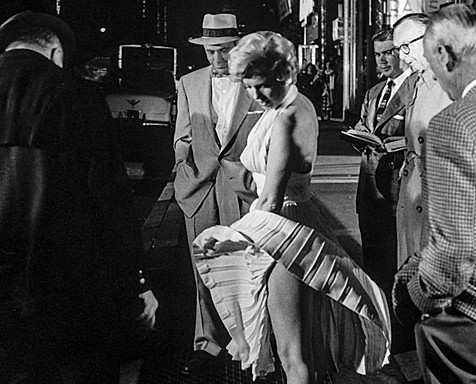Earlier in September, The Montreal Museum of Fine Arts debuted a retrospective of photographer George S Zimbel, an artist famous for his high-profile portraits of icons such as Marilyn Monroe, John F. Kennedy, Helen Keller, and Billy Graham. Zimbel has displayed his work everywhere—from New York’s Museum of Modern Art to Institut Valencia d’Art Moderne—but Montreal is a particular source of pride for him. Zimbel is a Canadian anomaly who left the United States to pursue his career rather than migrating south in hopes of achieving ultimate success. The exhibit is both a tribute to the international idol and a celebration of a local hero.
Zimbel found fame in celebrity, but his acclaim in humanity. Some of his portraits are iconic—his shot of Monroe’s flying skirt in The Seven Year Itch (1955) still adorns the walls of many teenagers. His profiles are so enticing because of his ability to see beyond the façade of celebrity; Monroe’s revealed thigh isn’t what makes the photo scandalous, but her uninhibited giggle. With every icon he photographs, he is able to capture this sense of humanity; he catches a smirk in President Truman, exasperation in Helen Keller, and gleaming pride in Billy Graham.
All of Zimbel’s photos use the same Leica camera, and most are black and white. Bright and spectacular, he captures the joy of the ’50s with a vibrancy that explains why grayscale is a trend that has persisted in the digital age.
He is intent on proving that the mundane is an illusion: There is meaning in every moment. Fittingly, the exhibit features Zimbel’s book Momento which he describes as, “a word I made up; it is neither ‘memento’ nor ‘moment’ (as in the decisive one). Sometimes it happens instantly, and sometimes you have to wait for it. It comes in its own sweet time.”
If his celebrity portraiture and foreign landscapes are his grandest, his small town shots are sweetest. One series, “The Pitcher,” follows a boy’s attempt at throwing a baseball, moving from frustration to anguish to glee with the movement and ease of a film. Zimbel gives personality to anonymity, so his portraits are even more exciting than the celebrity profiles that catapulted his career.
The entire exhibit was charmingly personal. Zimbel addressed the crowd in broken French, dedicated his work to his wife Elaine (who stood proudly at his side for most of the night), and spent the remainder of the evening greeting family and friends who came to support him. An American by birth, Zimbel boasts his grandchildren’s Quebecois education and persists on sticking to a language that is clearly foreign to him. However, while Zimbel prides himself on being “an honest photographer,” it is still unclear why he picked Montreal for this retrospective, let alone his home. The exhibit covered East Coast pleasantries in Massachusetts, wild city life in New York and New Orleans, and even exotic adventures in Venice. Canadian landscapes, however, were noticeably absent.
The gallery exhibits three years of his work, from 1953 to 1955, and in doing so is more celebratory than reflective. The thesis of Zimbel’s work is that it’s the ordinary that is most exciting, and yet by ignoring his Canadian home he ignores his own artistic motivations. Given his philosophy of celebrating the ordinary, it would have been nice to see what’s ordinary to him.
George F. Zimbel: A Humanist Photographer will be at the Montreal Museum of Fine Arts (1380 Rue Sherbrooke Ouest) until January 3, 2016. Tickets are $12 for ages 13 to 30.









Pingback: Ariella Garnaise of The McGill Tribune Reviews George Zimbel’s Exhibition “A Humanist Photographer” | Photography.xcuz.me